Lighthouses of Door County
On this Wisconsin peninsula, beacons are reminders of a more rugged past.
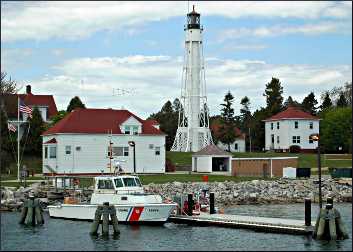
© Beth Gauper
Today, Door County is not a very rugged place. It's a favorite vacation spot for city folk, and it reflects their tastes with dozens of art galleries, bistros and B&Bs.
But once, Wisconsin's Door Peninsula was rough and remote, settled first by Scandinavian fishermen and loggers.
Navigating this long finger of land, which separates the wind-whipped expanses of Lake Michigan from Green Bay, was no treat for early mariners.
Its 250 miles of shoreline are littered with shipwrecks, especially around the treacherous strait between the tip of the peninsula and Washington Island, which French explorers named Porte des Morts, or Death's Door.
Lake Michigan doesn't have Lake Superior's rocky cliffs. But its many sandy reefs and shoals can snag a boat just as easily.
That's why lighthouses line the peninsula. Three of them can be toured all summer, and four others are easily seen. But the others can be reached only during Door County Maritime Museum's annual Spring Lighthouse Festival on the second weekend of June and the Fall Lighthouse Festival on the first weekend of October.
Tickets go on sale the first week of April and sell quickly. The most coveted ticket is the cruise to Plum Island, in the middle of the Death's Door Passage, which allows passengers to get off the boat to explore the 1895 range lights and the ruins of an 1848 lighthouse.
The Island Clipper Tour, which takes passengers to Rock Island for a hike to the 1837 Pottawatomie Light, Wisconsin's oldest, and past Plum Island and the 1873 Pilot Island lighthouse, also is very popular.
A third tour leaves from Fish Creek for Chambers Island, home of an 1868 lighthouse.
Other boat tours cross the Death's Door and explore lights in Baileys Harbor and Sturgeon Bay. On the Keepers' Kin Tour of Sturgeon Bay, relatives of lighthouse keepers share stories and memorabilia.
Throughout the tourist season, trips to Washington Island from Gills Rock on the Island Clipper include views of Plum and Pilot islands. The launch makes several trips a day from late May to early October.
For accommodations, see Where to stay in Door County.
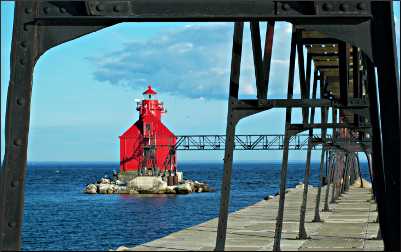
© Torsten Muller
The lights of Sturgeon Bay
On the Lake Michigan end of the Sturgeon Bay Ship Canal, the North Pierhead Light, nicknamed Big Red , is small but striking, especially in early evening, when it glows fire-engine red.
Visitors can walk toward it on the concrete pierhead, to which the 1882 fog-signal light is connected only by an elevated catwalk.
The towering 1899 Ship Canal Light and keeper's house sit on land just behind it, on an active Coast Guard station that's off-limits to visitors. The vertical tower shook in the wind, so skeletal supports were added in 1903.
People can drive to the lights or see them from the deck of boats that cruise the bay and canal daily in warm weather.
On the Green Bay side, at the mouth of Sturgeon Bay, cruise passengers also will see the 1883 Sherwood Point Light. In 1983, it became the last U.S. lighthouse on the Great Lakes to be automated.
Not all of the shipwrecks here were in the early days of navigation. Leathem Smith, the Sturgeon Bay shipyard owner who invented the self-unloader, drowned off the point in 1946 after the hull of his yacht swamped in a squall.
Why? It turned out that a bulkhead had been removed so the previous owner's father, President Franklin Roosevelt, could move around better in his wheelchair.
The Coast Guard uses Sherwood Point lighthouse as a retreat house, but the grounds are open to the public during the Lighthouse Festival.
Sturgeon Bay is the home of the Door County Maritime Museum, which holds many interesting exhibits about shipping and lighthouses.
For more about Sturgeon Bay, see The door to Door County.
Cana Island and range lights, Baileys Harbor

© Beth Gauper
Near the Door County village of Baileys Harbor, the shining white Cana Island Light is one of Lake Michigan's prettiest.
Visitors pick their way over a rock causeway, sometimes through water, to get to the 1870 lighthouse, which is operated by the Door County Maritime Museum.
The lighthouse is open daily from May through October. The tour costs $4, $2 for children 5-17; it's an extra $4 to climb the tower, which recently was renovated. There's a museum and gift shop inside the cream-brick keeper's quarters.
Nearby, two 1869 range lights were built the same year, one with a red light and one with a white light, which sailors lined up to get "on range" while entering the harbor.
Today, they're part of Ridges Sanctuary, a nature preserve. Don't miss the unusual ridges and swales in the preserve, which harbors many rare wildflowers, including 25 species of orchid. For more, see Spring in Door County.
Nearby, there's an old "bird cage" lighthouse, built in 1852 and closed after the range lights were built. You can see it by boat; Lakeshore Adventures in Baileys Harbor rents them.
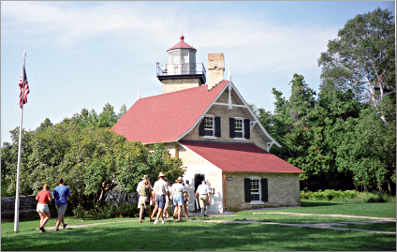
© Beth Gauper
Eagle Bluff Lighthouse near Fish Creek
Deep in Peninsula State Park, one of Wisconsin's most popular parks, Eagle Bluff Light can be reached by car, by foot or by bike; it's along the five-mile Sunset Trail, which brings in bicyclists from adjoining Fish Creek.
The cream-brick lighthouse was built on the bluff in 1868, and the light still is guiding ships past the shoals on Green Bay.
In 1960, the Door County Historical Society began restoring and furnishing the lighthouse for use as a museum, with the help of Walter Duclon, who was a year old when he, his parents and six brothers moved into the lighthouse in 1883.
His parents were the keepers for the next 35 years. The family amused itself with music, forming a band and performing at gatherings around the peninsula. Their rosewood piano remains at the keeper's house.
Tours are on weekends from late May to early June, then daily through mid-October.
Peninsula State Park is Wisconsin's most in-demand camping park and has some of the area's best bicycling and hiking. For more, see Outdoors in Door County.
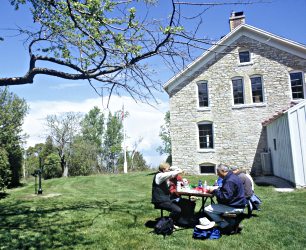
© Beth Gauper
Pottawatomie Light, Rock Island
Pottawatomie Light is the oldest lighthouse in Door County, built in 1858 after an 1836 station washed away, apparently due to faulty mortar. It's also the most remote, requiring two ferry rides from the mainland, to Washington Island and then Rock Island, now a state park.
Once on Rock Island, visitors hike a mile to the lighthouse, restored and furnished as it was in 1910. Volunteer docents recruited by the Friends of Rock Island give tours, pointing out the stone privy that is the oldest building in Door County.
They tell stories about the keepers, such as David Corbin, whom a government inspector found to be so lonely and sullen he was told to take a three-week leave so he could find a wife. He didn't and is buried alone not far from the light.
Another keeper did have a wife, who also was a midwife and kept newly born infants warm in her range's warming oven.
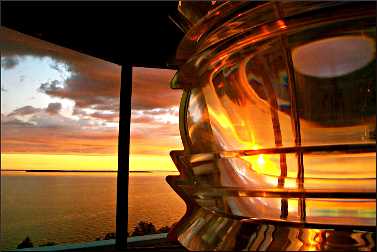
© Friends of Rock Island
Tours include the tower room, where the view includes the Grand Traverse Archipelago to the north. Boats preferred the passage between Rock Island and neighboring St. Martin Island to the Death's Door between Rock Island and Washington Island, so the keeper would have had many entries to make in his log.
The lighthouse is open daily from Memorial Day through Columbus Day. Pottawatomie Light allows volunteers to live in the house while giving tours; for details, see Living in a lighthouse.
Rock Island is a great place to camp and includes a historic boathouse. For more, see Wisconsin's Icelandic outpost.
Other Wisconsin lighthouses
In Wisconsin, there are lighthouses all the way from the 1880 Wind Point Light in Racine, near the Illinois border, to the 1913 breakwater light at the Superior entry to Duluth-Superior Harbor.
On Lake Superior, all of the Wisconsin lighthouses except the one in Superior are in the Apostle Islands National Lakeshore, whose 21 islands have the greatest concentration of National Park Service lighthouses in the nation.
For more, see Lighthouses of the Apostles.